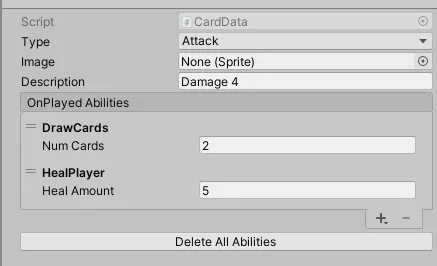我正在构建一款卡牌游戏,希望卡牌能够有一个干净的能力架构。
我创建了一个CardData ScriptableObject来存储每张卡牌的属性。我想让卡牌能力组合在一起,描述卡牌的功能,比如一张名为DrawAndHealCard的卡牌,当玩家打出它时,抽2张牌并恢复5点生命值。
我意识到这意味着我需要为每个CardAbility的变体创建一个具体的资源。所以DrawAndHealCard引用了两个资源:DrawCards2和HealPlayer5。这很荒谬,我希望所有数据都感觉像是在单个DrawAndHealCard上。
所以我了解了
我已经阅读了大量关于Unity序列化、SOs、Editor scripts等方面的材料... 真的在这方面遇到了困境,甚至要降级到在架构上感觉不那么优雅的东西。如果有更好的方法来做到这一点,我也愿意听取完全不同的建议。
下面的代码被简化了,但它是我正在努力解决的问题的核心。目前我所在的地方是
我意识到这意味着我需要为每个CardAbility的变体创建一个具体的资源。所以DrawAndHealCard引用了两个资源:DrawCards2和HealPlayer5。这很荒谬,我希望所有数据都感觉像是在单个DrawAndHealCard上。
所以我了解了
AssetDatabase.AddObjectToAsset(),这似乎是正确的方法,我可以将能力作为CardData资产的子资产,并且不必处理所有这些独立的资产的组织。所以现在我正在尝试构建一个编辑器来管理它,但进展缓慢。我已经阅读了大量关于Unity序列化、SOs、Editor scripts等方面的材料... 真的在这方面遇到了困境,甚至要降级到在架构上感觉不那么优雅的东西。如果有更好的方法来做到这一点,我也愿意听取完全不同的建议。
下面的代码被简化了,但它是我正在努力解决的问题的核心。目前我所在的地方是
onAddCallback似乎正确地添加了子资源,但onRemoveCallback则不能删除它。然而,我的 Clear All Abilities 按钮确实可以工作。我找不到任何关于这些材料的好文档或指南,所以我现在很迷茫。// CardData.cs
[CreateAssetMenu(fileName = "CardData", menuName = "Card Game/CardData", order = 1)]
public class CardData : ScriptableObject
{
public Sprite image;
public string description;
public CardAbility[] onPlayed;
}
// CardAbility.cs
public class CardAbility : ScriptableObject
{
public abstract void Resolve();
}
// DrawCards.cs
public class DrawCards : CardAbility
{
public int numCards = 1;
public override void Resolve()
{
Deck.instance.DrawCards(numCards);
}
}
// HealPlayer.cs
public class HealPlayer : CardAbility
{
public int healAmt = 10;
public override void Resolve()
{
Player.instance.Heal(healAmt);
}
}
// CardDataEditor.cs
[CustomEditor(typeof(CardData))]
public class CardDataEditor : Editor
{
private ReorderableList abilityList;
public void OnEnable()
{
abilityList = new ReorderableList(
serializedObject,
serializedObject.FindProperty("onPlayed"),
draggable: true,
displayHeader: true,
displayAddButton: true,
displayRemoveButton: true);
abilityList.onRemoveCallback = (ReorderableList l) => {
l.serializedProperty.serializedObject.Update();
var obj = l.serializedProperty.GetArrayElementAtIndex(l.index).objectReferenceValue;
DestroyImmediate(obj, true);
AssetDatabase.SaveAssets();
l.serializedProperty.DeleteArrayElementAtIndex(l.index);
l.serializedProperty.serializedObject.ApplyModifiedProperties();
};
abilityList.onAddCallback = (ReorderableList l) => {
var index = l.serializedProperty.arraySize;
l.serializedProperty.arraySize++;
l.index = index;
var element = l.serializedProperty.GetArrayElementAtIndex(index);
// Hard coding a specific ability for now
var cardData = (CardData)target;
var newAbility = ScriptableObject.CreateInstance<DrawCards>();
newAbility.name = "test";
newAbility.numCards = 22;
element.objectReferenceValue = newAbility;
AssetDatabase.AddObjectToAsset(newAbility, cardData);
AssetDatabase.SaveAssets();
AssetDatabase.Refresh();
serializedObject.ApplyModifiedProperties();
};
// Will use this to provide a menu of abilities to choose from.
/*
abilityList.onAddDropdownCallback = (Rect buttonRect, ReorderableList l) => {
var menu = new GenericMenu();
var guids = AssetDatabase.FindAssets("", new[]{"Assets/CardAbility"});
foreach (var guid in guids) {
var path = AssetDatabase.GUIDToAssetPath(guid);
menu.AddItem(new GUIContent("Mobs/" + Path.GetFileNameWithoutExtension(path)), false, clickHandler, new WaveCreationParams() {Type = MobWave.WaveType.Mobs, Path = path});
}
menu.ShowAsContext();
};
*/
// Will use this to render CardAbility properties
/*
abilityList.drawElementCallback = (Rect rect, int index, bool isActive, bool isFocused) => {
};
*/
}
public override void OnInspectorGUI()
{
serializedObject.Update();
DrawDefaultInspector();
abilityList.DoLayoutList();
// XXX: Ultimately don't expect to use these, experimenting with
// other ways of adding/deleting.
if (GUILayout.Button("Add Ability")) {
var cardData = (CardData)target;
var newAbility = ScriptableObject.CreateInstance<CardAbility>();
AssetDatabase.AddObjectToAsset(newAbility, cardData);
AssetDatabase.SaveAssets();
}
if (GUILayout.Button("Clear All Abilities")) {
var path = AssetDatabase.GetAssetPath(target);
Object[] assets = AssetDatabase.LoadAllAssetRepresentationsAtPath(path);
for (int i = 0; i < assets.Length; i++) {
if (assets[i] is CardAbility) {
Object.DestroyImmediate(assets[i], true);
}
}
AssetDatabase.SaveAssets();
}
serializedObject.ApplyModifiedProperties();
}
}
